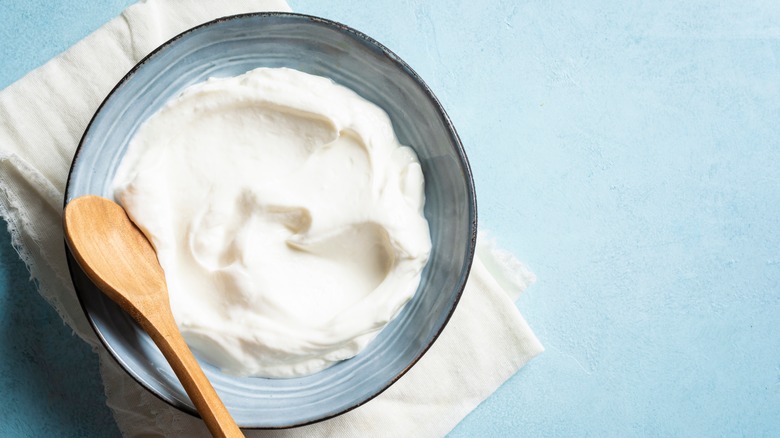What's The Difference Between Labneh And Greek Yogurt?
We may receive a commission on purchases made from links.
With the rise of yogurt brands like Fage and Chobani over the past couple decades, Greek yogurt has revolutionized the yogurt industry in the U.S. and become a beloved household ingredient. It's long been made in Greece, as well as other parts of the Mediterranean and Middle East. Meanwhile, labneh, a type of yogurt from the Levant region (which includes Lebanon, Syria, Palestine, Jordan, and Israel), is making a name for itself in the U.S. dairy industry. It's facing a projected growth of about 5% per year until 2029, after already experiencing a 12% jump in the market from 2019 to 2020.
The main difference between the pair is that Greek yogurt is strained once of its liquid whey, while labneh is strained twice. This means that labneh has a much thicker, smoother texture that's similar to cream cheese, as well as a richer taste.
Although it can pair deliciously with savory food, Greek yogurt is more commonly associated with sweeter flavors and commonly served with fruit and granola. In contrast, labneh is customarily paired with savory ingredients like pita, herbs, and olives. It's sometimes even rolled into balls and preserved in olive oil. When labneh is preserved this way, it can last up to three months, an outstanding amount of time for a dairy product. Without this method, but stored in an airtight container, labneh lasts closer to two weeks, similar to Greek yogurt. Keep an eye on it nonetheless, and if you're ever unsure, read up on how to tell when your yogurt has gone bad.
How to make labneh and Greek yogurt at home
Both labneh and Greek yogurt are low in lactose and packed with probiotics that support digestion and gut health. If you're having trouble finding labneh near you, you can easily make it at home. Add a sieve to a pot, line the sieve with a cotton cheesecloth, add in your plain yogurt (full fat is recommended, but up to you), then wrap the cheesecloth around the yogurt. Leave it in the fridge for 12 to 36 hours to make Greek yogurt and up to 72 hours to create labneh. If your goal is to make labneh, add a generous pinch of salt and a squeeze of lemon juice to your yogurt before wrapping it in the cheesecloth.
As a bonus, you'll be left with whey at the bottom of the pot that you can incorporate as a high protein milk replacement in baked goods and smoothies. If you already have Greek yogurt at home you can use it to make labneh, so long as you simply shorten the straining period. While you're already experimenting with dairy in the kitchen try making crème fraîche, a rich, tangy cream that can be made at home with buttermilk. Alternatively, give kefir a chance, which is different from yogurt, but still similar enough to be swapped for it in many recipes.

